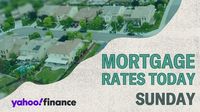Mortgage rates have taken a slight dip recently, offering some relief to potential homebuyers. As of April 20, 2025, the average 30-year fixed mortgage rate has decreased by 11 basis points to 6.79%, according to Zillow. Meanwhile, the 15-year fixed rate has also seen a decrease, down 10 basis points to 6.11%. This marks a welcome change for those looking to enter the housing market, as rates had surged above 7% just a week prior.
Despite this decrease, the overall sentiment in the market remains cautious. Rates are still relatively high, and experts warn that they may not drop significantly enough to improve affordability for many buyers. "Rates are down a bit from last week, but they haven't dropped enough to improve affordability," noted one analyst. The uncertainty surrounding tariffs and their potential impact on inflation adds another layer of complexity to the current mortgage landscape.
As it stands, the current mortgage rates on April 20, 2025, are as follows: 30-year fixed: 6.79%, 20-year fixed: 6.66%, 15-year fixed: 6.11%, 5/1 ARM: 6.99%, 7/1 ARM: 7.41%, 30-year VA: 6.33%, 15-year VA: 6.01%, and 5/1 VA: 6.31%. In terms of refinancing, the rates are slightly higher, with the 30-year refinance rate at 6.83% and the 15-year refinance rate at 6.22%.
For many buyers, the decision between a 15-year and a 30-year mortgage can be daunting. A $300,000 mortgage with a 30-year term at a 6.79% interest rate would result in a monthly payment of approximately $1,954, leading to a total interest payment of $403,360 over the life of the loan. In contrast, a 15-year mortgage at a 6.11% rate would require a monthly payment of $2,549, but the total interest paid would be significantly lower at $158,898. This stark difference highlights the importance of considering both short-term and long-term financial goals when selecting a mortgage type.
Fixed-rate mortgages provide stability, locking in the interest rate for the entire loan term. However, adjustable-rate mortgages (ARMs) can offer lower initial rates, though they come with the risk of increasing rates after the fixed period ends. For instance, a 7/1 ARM currently has a rate of 7.41%, which is higher than many fixed-rate options. As such, potential borrowers are advised to carefully evaluate their options and consult with lenders to find the best fit for their financial situations.
Improving one's chances of securing a lower mortgage rate often hinges on several factors, including credit scores, down payments, and debt-to-income ratios. Lenders typically offer the most favorable rates to borrowers with excellent credit and substantial down payments. As such, individuals looking to buy a home may want to focus on enhancing their financial profiles before diving into the market.
When comparing lenders, it’s crucial to look beyond just the interest rates. The annual percentage rate (APR) should also be considered, as it encompasses not only the interest rate but also any associated fees. This can provide a clearer picture of the true cost of borrowing.
As for future predictions, mortgage rates are expected to remain volatile in the coming months. Experts suggest that the Federal Reserve's actions regarding inflation will play a significant role in shaping the mortgage market. If inflation continues to rise, rates may follow suit. Conversely, if the economy shows signs of slowing down, the Fed may lower rates to stimulate growth, potentially leading to lower mortgage rates.
In the broader context, the housing market is facing challenges due to economic uncertainties. The potential for tariffs to either drive inflation higher or trigger a recession complicates the outlook for both mortgage rates and housing affordability. The phenomenon of stagflation, where inflation rises alongside stagnant economic growth, could further impact the decisions of the Federal Reserve and, consequently, mortgage rates.
As it stands, the average 30-year mortgage rate has increased from 6.45% in March to approximately 6.80% now. Meanwhile, the average 15-year mortgage rate has risen from 5.79% to around 6.10%. These increases reflect the ongoing economic fluctuations and the Fed's attempts to control inflation.
In summary, while there has been a slight decrease in mortgage rates, the overall market remains unpredictable. Buyers should remain vigilant, focusing on their financial health and the various mortgage options available. As the economic landscape continues to shift, those looking to purchase a home should be prepared for possible changes in mortgage rates and the broader housing market.





